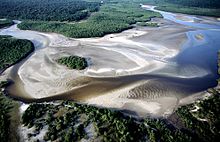Bissagos Islands
This article includes a list of general references, but it lacks sufficient corresponding inline citations. (June 2017) |
| Designations | |
|---|---|
| Official name | Archipel Bolama-Bijagós |
| Designated | 14 January 2014 |
| Reference no. | 2198[1] |


The Bissagos Islands, also spelled Bijagós (
There is a high diversity of ecosystems: mangroves with intertidal zones, palm forests, dry and semi-dry forests, secondary and degraded forests, coastal savanna, sand banks and aquatic zones. The archipelago was declared a
Demographics
The population is estimated at about 30,000 (2006) and the ethnic group Bissago (Portuguese: Bijagó) predominates. It has a relatively youthful population due to high birth rates and low life expectancy.[citation needed]
Economy
The economy is largely rural, with many families living from subsistence farming and fishing. There is some tourist activity, mostly boat charters from neighboring Senegal. Lack of infrastructure and communication links prevent the development of the islands' tourism potential.[
History
In pre-European colonial times, the islands were central to the trade along the coast of
In 1849, with the people of the Bissagos still fiercely independent, the British and French mounted a joint expedition to 'pacify' the islands, but they were repulsed. The Portuguese tried several times to put down 'tax revolts' in the islands in the early 20th century but largely failed.[7] The islands were not formally annexed by Portugal until 1936.[8][9]
The Bissagos were visited by Austrian anthropologist and photographer Hugo Bernatzik in 1930–1931, who documented daily life among the Bidyogo people.[10]
The London School of Hygiene and Tropical Medicine is conducting research into infectious diseases on the islands. Because they are so isolated there is less danger of contamination of the results than in other places.[11]
Culture
Due to difficulties of communication with mainland Guinea-Bissau that persist to this day, the population has a considerable degree of
Some authors argue that Bijago culture tends to be matriarchal, with women managing the household, the economy, law, as well as initiating courtship (women choose their husbands and terminate the matrimony).[12] Other sources dispute this and suggest that closer examination has revealed a fundamentally patriarchal society where women, in spite of their substantial participation in material production and important roles in social, political, and religious matter, remain essentially unequal to men.[13] A 2016 study suggested that female status in Bijagos society was diminished during the slave trade era (likely due to European influence) but has become more valued again in more recent times.[14]
In 2012, a study by Bissau-Guinean sociologist Boaventura Santy examined the social representations of the people of the island of Formosa Bijagó about possible threats from climate change. The study concluded that for "the Bijagó the natural and the social are inextricably linked, to the extent that a crisis in the social system would have negative effects" on the natural system.[15] In particular, it was the lack of harmony between the community, ancestors and the supernatural world that was seen as causing environmental dissonance.[16]
Art
The Bissagos peoples produce many artifacts for daily use and ritual following a traditional iconography that is unique to their culture, and shows variations from island to island. Among the most striking
Notable people
- Benkos Biohó, Former African king who was shipped to Cartagena, Colombia during the slave trade but managed to escape and found the maroon village known as San Basilio de Palenque.
See also
References
- ^ "Archipel Bolama-Bijagós". Ramsar Sites Information Service. Retrieved 25 April 2018.
- ^ "Focus - Guinea-Bissau's Bijagos Islands: A sanctuary of biodiversity under threat". 10 September 2021.
- Agência Lusa, Visão magazine
- ^ Stallibrass 1889, pp. 595.
- ^ Rodney 1966, pp. 139.
- ^ Rodney 1966, pp. 205.
- ISBN 978-0-8108-8027-6.
- ISBN 9781139643382. Retrieved 2015-01-26.
- ISBN 9782735116829. Retrieved 2015-01-26.
- ^ Geheimnisvolle Inselntropen Afrikas: Frauenstaat und Mutterrecht der Bidyogo; ein Forschungsbericht 1933
- ^ "Could these beautiful islands help stop killer diseases?". BBC. 14 November 2018. Retrieved 26 December 2018.
- ^ Guinea, Borders, and G. M. T. Time. "Guinea-Bissau." CABO 25.17 (2014): 17.
- ^ Historical Dictionary of the Republic of Guinea-Bissau, 2013, page 51
- ^ Lundy, B., Fernandes Jr, R. M., & Lartley, K. (2016). The Integrity of Women in Re-making a Nation: The Case of Guinea-Bissau. Journal of Global Initiatives: Policy, Pedagogy, Perspective, 11(1), 4.
- ^ Santy, B. R. V. H. (2012). As representações sociais das mudanças do clima e suas implicações no processo de territorialização: Os Bijagós da ilha de Formosa, Guiné-Bissau.
- ^ Nuny, Yasmina. "HOW TO SOLVE CLIMATE CHANGE, ACCORDING TO THE BIJAGÓS OF GUINEA-BISSAU". Retrieved 13 January 2021.
Sources
- "Bijagós Islands." Encyclopædia Britannica
- An article about the land and the people of Bijagós Archipelago
- Rodney, Walter (May 1966). A History of the Upper Guinea Coast, 1545-1800 (PDF) (Thesis). ProQuest.
- Stallibrass, Edward (1889). "The Bijouga or Bissagos Islands, West Africa". Proceedings of the Royal Geographical Society and Monthly Record of Geography. 11 (10). Royal Geographical Society: 595–601. JSTOR 1801045.
- TVEDTEN, Inge The Difficult Transition from Subsistence to Commercial Fishing. The Case of the Bijagbs of Guinea-Bissau. Pages 129 to 130 In VAN GINKEL, Rob and VERRIPS, Jojada (editors) MAST (Maritime Anthropological Studies) Vol. 3, No. 1 1990 Krips Repro, Meppel, The Netherlands.
